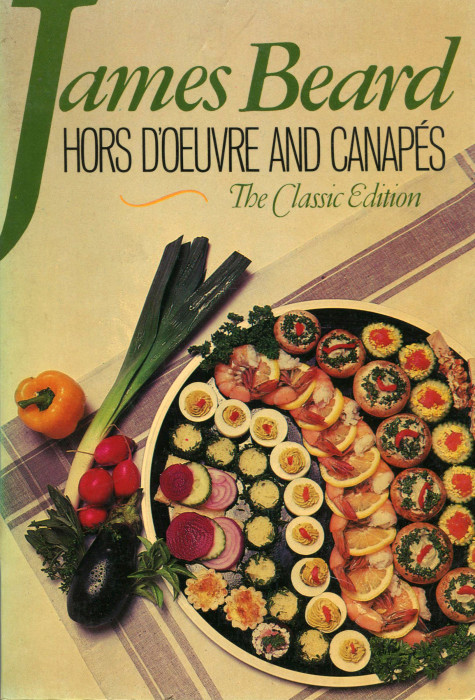In the 1930’s a man named James Beard moved from the Pacific Northwest to his city of destiny: New York. The ultimate gourmand, Beard and some friends wanted to fashion a food business and, after consideration and experimentation, they formed a small shop devoted to party appetizers. The shop eventually went away, but that shop and its food was remembered.
A publisher contacted Beard and asked him if, in just six weeks, he could prepare a book based on the shop’s wonders. Beard did just that and this book, Hors D’Oeuvre and Canapés, was published in 1940. It was his first book and represents his attempts to forge grand cuisine at time when America was still bogged in the Depression and the world was already at war.
It was a strange, transitional time. But Beard knew that some elements of our culture, surely food, were sure to survive, evolve, and ultimately become the foundation for a country in a tumultuous world.
Beard begins this book explaining that hors d’oeuvre [never hors d’oeuvres with an “s”] literally means outside the meal. He believed the origins were in China, passed to Russia, and then spreading throughout European society. In the United States, hors d’oeuvre first appeared, not in New York, but in the bars and taverns of San Francisco where they were an element of the “free lunch” offered to the working class. Even then, institutions made money selling beer and booze. The food was a loss-leader.
Prohibition ended those bars and the free lunch. When Prohibition ended, the idea of “little foods” reappeared nationwide, now officially labeled as hors d’oeuvre.
Reading this book now is really a hoot. In 75 years, things have changed just a bit. Our styles, our recipes tend to be more complex and often more sophisticated than in 1940. Or so we like to think. But when reading some of the recipe ideas below, you may feel that we have made some enormous jump and, along the way, lost some deliciously important ideas. You won’t find many of Beard’s sandwich concepts at your local Subway. That’s why you have a home kitchen.
It is a worthy journey to see what Beard offers in this little volume of less than 200 pages.
In the chapter Cold Hors D’Oeuvre for Cocktail Parties, Beard suggests these items:
Danish Ham Rolls made with prosciutto and smoked salmon
Beef Rolls with Pate de Foie Gras
Veal Rounds Topped with Herbed Butter
Turkey Rolls Filled with Brazil Nuts
Cheese Balls: Chive, Olive, Curry, and Mexican
Dill Pickles Stuffed with Crab and Russian Dressing
Radishes Wrapped with Anchovies
In the chapter Canapés Beard gives bread recipes — brioche, puff pastry, and flaky pastry — before offering a sea of butters:
Anchovy with and without hardboiled eggs
Chutney
Lobster two ways
Fish Based: Smoked Salmon and Sturgeon and Sardine
His many spreads include Roquefort, Stilton, Anchovy multiple ways, one with Tongue and eight with Ham including one with equal parts of ham and chopped roast beef married with dry mustard and mayonnaise.
Beard presents ideas for stuffed breads, like the French flute that is hollowed out, spread with garlic butter, and then filled with steak tartare. He recommends lots of salt and pepper and green onions on the side.
In the Cocktail Sandwiches chapter, Beard begins with a two page list of sandwich fillings and bread combinations — he was always obsessive about using the just the right bread for just the right feeling:
Baked ham on nut bread spread with tomato butter
Chopped ham with chopped ripe olive sand grated cheese
Thinly sliced tongue with Roquefort butter
When drinking champagne, Beard insists that only white bread be used, ideally with pate de foie gras or white chicken meat, never dark. There are pages here of open-faced and hot sandwiches including:
Bacon and Hazelnut
Chicken Giblet
Cocktail Hamburgers — Yes, Beard invented the slider!
For a cold day there is a chapter on Hot Hors D’Oeuvre for Cocktail Parties proposing:
Ham and Olive Canapés
Hardboiled Egg and Sardine Canapés
Barquettes [flaky pastry boats] filled with Curried Chicken, Lamb Kidney, Crawfish, or Crabmeat
Croquettes: Chicken, Lobster, Clam, Beef, Corned Beef
Turnovers [we call them empanadas!]: Smoke Tongue, Haddock, Sardines, Veal Curry
Leafing through this book, you are sure to become both hungry and curious. Why did some ideas persist and others fade? How did his slider idea not continue and grow into a fashion trend right then? Maybe it was World War II, but it took over 60 years for the slider idea to bounce back to prominence. I think that mean the pages of Hors D’Oeuvre and Canapés must contain other lost treasure gems. You might not start a new food trend by resurrecting one of the lost ideas here, but you surely will have a cocktail party feast everyone will remember.

